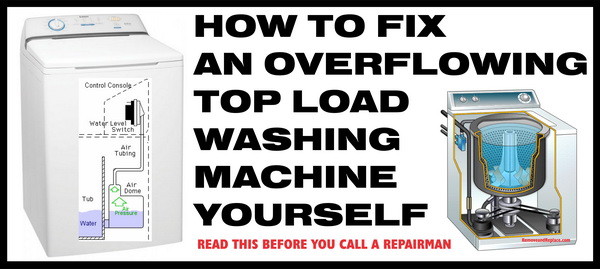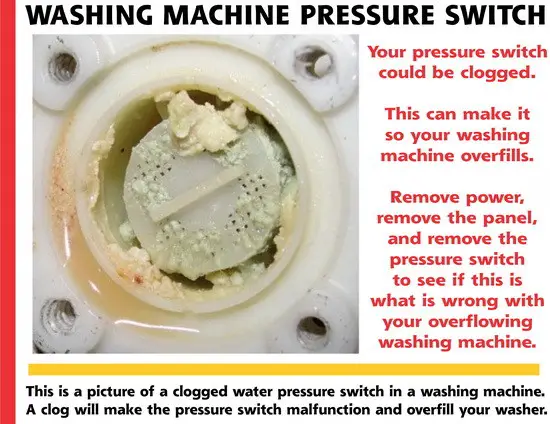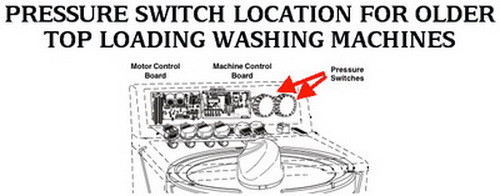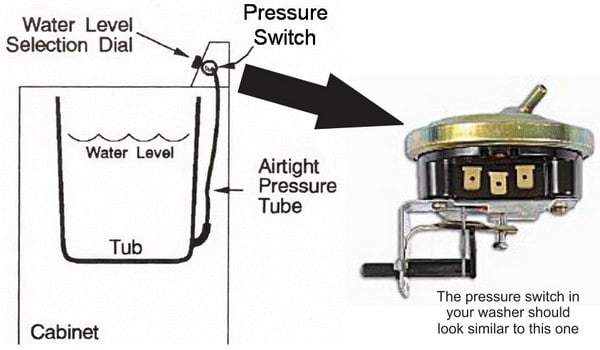Washer overflows. What causes the washing machine to overflow and how do I fix it myself?
What can cause your washer to overflow?
Clogged water inlet valve
A clogged water inlet valve can prevent water from flowing into the washing machine, causing it to overflow and drain constantly. Dirt, sediment, and debris can accumulate inside the valve, restricting water flow.
Faulty water level control
The water level control is responsible for monitoring the water level inside the washing machine. If it’s malfunctioning, the machine may not stop filling with water, leading to an overflow and constant draining.
Damaged pressure switch
A damaged pressure switch can also cause a washing machine to overflow and constantly drain water. The pressure switch senses the water level and turns off the water supply when the desired level is reached. If it’s not working correctly, the machine may not stop filling.
Blocked pressure hose
The pressure hose connects the pressure switch to the tub. If the hose is blocked, kinked, or damaged, it can affect the pressure switch’s ability to accurately measure the water level, leading to overflow and constant draining issues.
Malfunctioning drain pump
The drain pump is responsible for removing water from the washing machine. If it’s not functioning properly, the machine may not be able to drain water correctly, causing it to overflow.
Overloading the machine
Filling the washing machine with too many clothes can obstruct the proper flow of water, leading to an overflow. It is crucial to follow the recommended load capacity for your specific machine to prevent this issue.
Inadequate water supply pressure
Low water supply pressure can lead to imbalances in the washer’s drainage system, causing it to overflow. Ensuring that the water supply pressure is adequate can help prevent this issue.
Here are ways to fix your overflowing washer
Step 1: Inspect the water inlet valve
Turn off the water supply to the washing machine and disconnect the power. Remove the hoses connected to the water inlet valve and inspect it for any debris or clogs. Clean the valve using a toothbrush and a mixture of water and vinegar. Reattach the hoses and turn on the water supply to check if the issue is resolved.
Step 2: Check the water level control
Disconnect the power and locate the water level control, usually found behind the control panel. Inspect it for any visible damage or loose connections. If necessary, replace the water level control with a new one.
Step 3: Test the pressure switch
To test the pressure switch, disconnect the power and remove the control panel. Locate the pressure switch and remove the hose connected to it. Blow air into the hose to ensure it’s not blocked. Reconnect the hose and test the pressure switch with a multimeter. If the switch is faulty, replace it with a new one.
Step 4: Examine the pressure hose
Inspect the pressure hose for any kinks, damage, or blockages. If the hose is damaged, replace it with a new one. If it’s blocked, clean it with a long brush or a pipe cleaner.
Step 5: Inspect the drain pump
Disconnect the power and locate the drain pump, usually found at the bottom of the washing machine. Check for any visible damage, debris, or clogs in the pump. If necessary, replace the drain pump with a new one.
Step 6: Do not overload washer
When loading your washing machine, be careful not to overload it. Do not add large blankets in with regular clothing. Wash large items separately. An overloaded washer can cause an overflow from just simply too many items in the drum. Overloads can cause water to overflow and cause problems and flooding.
Step 7: Water pressure to washer
The water pressure going to the washer can cause an overflow if it is too low. What happens is the water inlet valve does not receive the signal to turn off and stop the flow of water. So check that the water pressure is sufficient. Usually 20 to 25 psi and up is needed.
Preventive maintenance for washing machine
Clean the water inlet valve regularly
Regularly inspect and clean the water inlet valve to prevent clogs from forming. This will ensure that the valve operates efficiently and helps avoid overflow and constant draining issues.
Avoid overloading the washing machine
Overloading the washing machine can cause the water level to rise above the intended limit, leading to overflow and constant draining problems. Always follow the manufacturer’s guidelines for load capacity.
Use the correct detergent
Using the wrong type of detergent can create excessive suds, which can cause the washing machine to overflow. Always use the detergent recommended by the manufacturer for your specific machine.
Regularly inspect hoses and connections
Check hoses and connections for any signs of wear, damage, or leaks. Replace damaged hoses and tighten loose connections to prevent water from overflowing and constantly draining.
Schedule regular maintenance
Regular maintenance can help identify potential issues before they become significant problems. Consider scheduling a professional maintenance check for your washing machine every year to ensure it operates efficiently and to avoid overflow and constant draining issues.
If you still have a washer that is overflowing after reading and troubleshooting the information above, please leave a comment below and we can help you fix your washer.







I have a top load washer that overfills. The pressure switch functions normally and the pressure tube is clear. When the tub is filling, I can see water going into the pressure chamber but only fills slightly; leaving no water to run up the water tube. When I unplug the pressure tube from the pressure chamber, I notice the water begins to rise in the chamber. What is the problem?
Matt,
If the water level pressure switch is securely connected electrically, then check the water level pressure switch with a meter to be sure it is working and is getting power.
If so, then check the water inlet valve as it may not be shutting off in time.
Also if there is a small clear tube attached to the water pressure switch, be sure it is clean and securely attached.
At times the small clear tube will clog up and prevent the pressure switch from working properly.
-RR
I have a GE WHRE5260E1WW that had overfilled and began to spill out onto the floor. I’ve checked the water level sensor behind the panel and in the front panel where the opposing end connects. Both are secure and there doesn’t appear to be any blockages. What else can I look for?
Crystal,
What is the model number of your washing machine?
-RR
We have replaced the water level switch and the washer is still overfilling with water. It worked half way through the wash then the cycle stopped. When we restarted it the washer just kept filling and wouldnt stop til we stopped it told it to drain and spin. What else could be the problem?
John Boyd,
Try shutting off power to the washer. If the washer still overflows even when it is not getting power, this indicates that the water inlet valve is defective. If the water inlet valve is defective, replace it.
If that is not the issue, you may need to check to be sure the water pressure switch is in working condition.
-RR
We have an Asko 20005 Excellence washing machine…20 years old. Its works fine but can overflow. The pressure switch has been checked and seems to work. We have unusually high water pressure (eg. I don’t need to buy a pressure cleaner for cleaning cars!). I turned down the water supply tap to 50% and all overflows stopped, regardless of which type of wash we did. Could it be that our domestic water supply is just too high to have the machine run on full pressure?
Hallie,
Yes the washer water pressure switch is located usually (on top load washers) behind the front panel and to the right. If it is clogged or has hard water blocking it, the washer may overfill or under-fill… Remove power to machine and remove front panel to check to be sure it is not clogged. Take it out of the machine and clean it completely. Clean out the tube also. Reinstall in the washer and run a test wash. This should fix your issue.
-RR
This question is for my top-loading LG WT4870 CW machine. It’s filling with water to the brim no matter how large or small my laundry load is. It’s not overflowing all over the floor, but water is leaking out of the drum when it agitates because it’s overfilling. I believe it may be the pressure switch. Does anyone have any tips on checking that valve for clogging and/or replacing the part if needed?
I believe the part is not located in the top panel of the machine, but rather in the back, beside the drum. Any advice would be great. Thanks all and happy new year!
Figured out we needed to cut the end of the hose off to make it a snugger fit but thank you for replying.
Michelle,
Most likely water pressure switch hose is not secure. Probably fell off or gunk in it or switch itself may be gunked up. Check once again and be sure it is secure.
-RR
My washer was filling up but then stopping. First guess was lid switch so I tested it with a jumper wire and it didn’t fix the problem. After a couple hours it just started working again. It happened again a couple months later when once again cleaning pillows. I figured the load was big and causing water to splash up onto wires/circuit board so I unplugged it and waited a few hours and when I plugged it back in it was fine. Figured it needed to dry out. Happened again today but with just a regular load (all be it full) of clothes. Unplugged it and waited but nothing. Tried messing with the lid switch again and again it didn’t work. When I removed some clothes the water came on to fill the tub back up. So I figured the overload sensor got triggered but wouldn’t reset. In an attempt to figure out how to fix it I removed the pressure valve tube and I heard the pressure being released. I replaced the tube but now the water wont stop running unless I turn off the machine. Any help? Old Kenmore 80 series (inside top of washer looks very similar to what’s in video). Thank you.
Emanoyhl,
We would suggest calling the manufacturer of your washer and asking to speak to technical support. It may be possible for them to email you a wiring schematic for the pressure switch you need to reinstall. We would love to assist but we are unable to find any relevant wiring guides or diagrams that will help us help you. Try calling the toll free number for support.
-RR
hi there!
yes, the pressure switch under each terminal has numbers, and the wires are color coded….
the pressure switch numbers are as follows:
31, 36, 24, 11, 13, 32, 21, 22, 12, 34 (there are 10 terminals total, but only 9 wires total) – i do know that the blue wire goes to terminal 24 (because that was the only one “alone”)
the wire colors are: (single)black, (double)green, (single)blue, (single)brown, (1)brown/(1)black, (single)red, (1)brown/(1)black, (1)red/(1)yellow, and (1)red/(1)yellow
when i say “brown/black and red/yellow” they are actually 2 wires together, solid red and solid yellow, and solid brown with solid black clamped per terminal end…. the red/yellow for example, the yellow comes from the water inlet valve, and is terminal clamped with a red wire that goes to another terminal clamp with another yellow wire that comes from the timer box (so that red wire for the 2 sets of red/yellow is actually like a bridge between the yellow wires) – the green wire also comes from the water inlet valve and is also doubled at the terminal clamp which then goes to the timer box – all the wires are 2 wires per 1 terminal clamp except for the red, brown, blue, and black – the blue and brown wires are from the power supply that goes to power switch, then from there to timer, then from there to this pressure switch – the 2 pairs or brown/black wires come from the timer box, but the single black wire comes from one of the brown/black set….
i hope that made sense? :)
thanks again in advance! i could supply photos if necessary!!
Hi Emanoyhl,
If you do not have the manual and have zero reference to rewire the pressure switch, are there any numbers or letters next to each wire connector on the switch? Are the wires from the washer to the pressure switch color coded or numbered?
-RR
Hi there! i have a Pitsos Vario Inox 4600 front load washing machine and i need to know how to wire the pressure switch?
Do you have a diagram or service manual or any photos or info – I have scoured the internet for days now and i cannot find any information.
This is what i have:
Low pressure control (9 contacts-3 levels 62/25, 77/39, 90/55) for washing machine PITSOS/BALAY Low pressure control (9 contacts-3 levels 62/25, 77/39, 90/55) for washing machine PITSOS/BALAY
Code: 33902
Low pressure control (9 contacts-3 levels 62/25, 77/39, 90/55) for washing machine PITSOS/BALAY
and it fits the following machines also:
BALAY
BOSCH
(E-Nr. : WFB2000/01 , E-Nr. : WFB200000/07 , E-Nr. : WFB2010GR/11 , E-Nr. : WFB2010GR/03 )
PITSOS
(E-Nr. : WFA2070/00 , E-Nr. : 4600/07 model:(MOD:) : 4600 , E-Nr. : 4900/07 model:(MOD:) : 4900 , E-Nr. : WFBPI03GR/16 , E-Nr. : LI4600/07 , E-Nr. : 4600/08 , E-Nr. : 4600/02 , E-Nr. : LI4600/17 , E-Nr. : WFBPI02GR/22 , E-Nr. : LI4600/01 )
SIEMENS
(E-Nr. : WM21000/02, WM21000/01, WM21000SK/01, WM21000SK/02, WM21000CH/01 )
Basically when i removed the switch to replace it, there is no plug to simply plug the wire assembly back into it – they are all separate wires – i had taped them so that i could re insert them however, the tape didn’t hold and when i came back to it the wires all separated…. on my machine there are no wiring plugs they are all separate wires with clips to insert into each prong/terminal…. hence my dilemma, unsure of how to wire it back together…
Please help! :) thank you in advance!